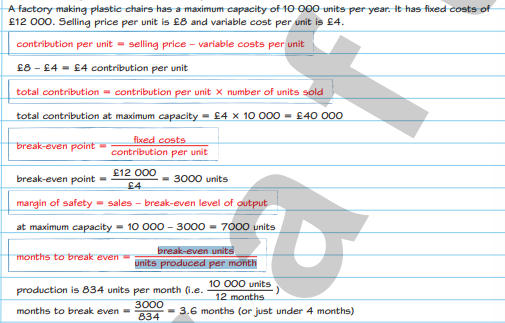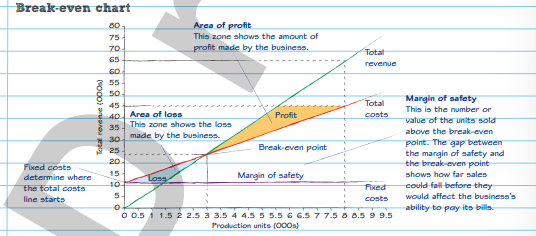Beak even
0.0(0)
0.0(0)
Card Sorting
1/25
Earn XP
Description and Tags
Study Analytics
Name | Mastery | Learn | Test | Matching | Spaced |
|---|
No study sessions yet.
26 Terms
1
New cards
contribution per unit =
selling price – variable costs per unit
2
New cards
total contribution =
contribution per unit × number of units sold
3
New cards
break-even point =
fixed costs/contribution per unit
4
New cards
margin of safety =
sales – break-even level of output
5
New cards
months to break even =
break-even units/units produced per month
6
New cards
example of one

7
New cards
Break- Even chart

8
New cards
Area of profit
This zone shows the amount of profit made by the business
9
New cards
Margin of safety
This is the number or value of the units sold above the break-even point. The gap between the margin of safety and the break-even point shows how far sales could fall before they would affect the business’s ability to pay its bills.
10
New cards
Area of loss
This zone shows the loss made by the business
11
New cards
Fixed costs
Determine where the total costs line starts
12
New cards
Using Break-Even
Break-even is a valuable management tool used by businesses to plan, monitor, control and set targets. As part of break-even, contribution per unit has both limitations and benefits.
13
New cards
Planning
break-even helps the business to work out how many items it needs to sell over a certain period to cover its costs and to use this information to set a price that will enable it to make a profit
14
New cards
Monitoring
break-even alerts the business to potential problems, e.g. increased fixed or variable costs or a fall in sales, allowing it to take steps to fix them in good time
15
New cards
Control
break-even can be used to identify where costs are increasing, allowing the business to take action to control this.
16
New cards
Target -Setting
Break-even helps a business to set targets for sales, unit costs, contribution, and profit.
17
New cards
Contribution benefits
A business is able to see whether the products it produces actually cover its own variable costs.
This is used to set the price of the product in relation to direct production costs.
Contribution per unit may be very low, so the business will need to sell a large number to cover the fixed costs.
This is used to set the price of the product in relation to direct production costs.
Contribution per unit may be very low, so the business will need to sell a large number to cover the fixed costs.
18
New cards
Contribution limitations
Contribution per unit on certain products may be extremely high.
\
In each case the contribution per unit is distorted and may not be valuable.
\
In each case the contribution per unit is distorted and may not be valuable.
19
New cards
Variable costs
The variable costs relate to the additional costs incurred per unit
20
New cards
Total Costs
Total costs are the total of these two figures.
21
New cards
Total Revenue
is calculated by multiplying the number of units sold by the price the business received for them.
22
New cards
selling price
if the selling price is increased total revenue will be greater and rise more quickly. If it falls then total revenue will drop
23
New cards
Fixed costs
total costs will increase if fixed costs increase
24
New cards
Variable costs
these will affect the total costs line, shifting it up if unit costs increase and down if they fall.
25
New cards
Break-even may have to be recalculated when there is a change in…
Selling price, fixed costs, variable costs.
26
New cards
Stages necessary to work out break-even
The variable costs, to Total costs, to Total Revenue.